
Michael Gilbert in his younger days
As I mentioned the other day, I have acquired enough Michael Gilbert novels in the last while to devote an entire post to them en masse. Lately I picked up an armful of paperbacks, and I went out and supplanted that with e-books as my fancy took me. As you will soon see, when I want to read an author, I want them ALL. I’m still waiting on a few, but I’m determined to read everything of his, it’s all that good. And I had at least one discovery of a great novel that I hadn’t read before.
There’s an excellent tribute to and biography of Gilbert here, by Martin Edwards, who took over editing the CWA anthologies from him and obviously feels the same way about this writer as I do — a brilliant man whose death in 2006 cost the world a great writer of the old school. You’ll find a full bibliography here.
 I’ve already had quite a bit to say about a couple of his books: The Crack in the Teacup (1966), Petrella at Q (1977), and his first mystery, Close Quarters from 1947. I think it’s clear that this discussion will be coloured by the fact that, just in general, I really like Gilbert’s writing style and I’d overlook a lot of minor flaws because he tells stories that I enjoy reading. So if you’re looking for any vitriol about this particular author, you’re not likely to hear it from me. He’s an excellent writer and I recommend you read your way through him start to finish. As a stylist, he writes the elegant prose of a lawyer, which he was; I understand he used to write his fiction on the train as he traveled to and from London to his office.
I’ve already had quite a bit to say about a couple of his books: The Crack in the Teacup (1966), Petrella at Q (1977), and his first mystery, Close Quarters from 1947. I think it’s clear that this discussion will be coloured by the fact that, just in general, I really like Gilbert’s writing style and I’d overlook a lot of minor flaws because he tells stories that I enjoy reading. So if you’re looking for any vitriol about this particular author, you’re not likely to hear it from me. He’s an excellent writer and I recommend you read your way through him start to finish. As a stylist, he writes the elegant prose of a lawyer, which he was; I understand he used to write his fiction on the train as he traveled to and from London to his office.
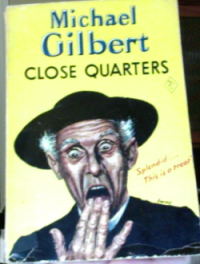 There are at least three different types of story that Gilbert writes; the trouble is, it’s not easy to boil them down into categories with succinct and tidy labels, at least for me. As well, Gilbert didn’t usually write long series of books; the most in a series is six. He’s one of the few writers who attracts my attention with a volume of short stories. It’s kind of a peculiarity of mine — I’m just not all that interested in other authors’ short stories because usually they’re written to make or illustrate a single point, and once I get it, there’s no more flavour. But Gilbert writes volumes of linked stories and they seem to carry a full-length narrative for me. Anyway, he has a few series, lots of non-series novels, and volumes of short stories. To quote Martin Edwards, “He is never dull, he never writes the same book twice.” The story types are anything but rigid; it’s more like he has a couple of preoccupations that show up in many of his novels (the law, for instance, and struggling against injustice) and then he’s wonderfully inventive and inter-relative about the rest.
There are at least three different types of story that Gilbert writes; the trouble is, it’s not easy to boil them down into categories with succinct and tidy labels, at least for me. As well, Gilbert didn’t usually write long series of books; the most in a series is six. He’s one of the few writers who attracts my attention with a volume of short stories. It’s kind of a peculiarity of mine — I’m just not all that interested in other authors’ short stories because usually they’re written to make or illustrate a single point, and once I get it, there’s no more flavour. But Gilbert writes volumes of linked stories and they seem to carry a full-length narrative for me. Anyway, he has a few series, lots of non-series novels, and volumes of short stories. To quote Martin Edwards, “He is never dull, he never writes the same book twice.” The story types are anything but rigid; it’s more like he has a couple of preoccupations that show up in many of his novels (the law, for instance, and struggling against injustice) and then he’s wonderfully inventive and inter-relative about the rest.
 So think of these as loose ways to organize Gilbert’s work. As I’ve said, there are preoccupations — the law, justice, courtroom drama, triumph of the little man — and a few types. The three main types I’ve noticed are:
So think of these as loose ways to organize Gilbert’s work. As I’ve said, there are preoccupations — the law, justice, courtroom drama, triumph of the little man — and a few types. The three main types I’ve noticed are:
- Straightforward puzzle mysteries, often with Inspector Hazelrigg but there’s a lot of standalone novels that hearken back to the Golden Age. There’s also a strong thread of courtroom drama in many of his later works but it’s not restricted to this type.
- One man fighting against great odds. As I said, it’s not easy to describe these, but The Crack in the Teacup is a good example. Sometimes the protagonist is damaged by an powerful antagonist and spends the book getting his own back; sometimes the protagonist sees injustice and merely wants to see justice triumph. Although there is definitely a case for calling the stories about Inspector Petrella police procedurals, I ended up thinking of them in this category because Petrella is constantly battling against both criminals and the police apparatus. There’s also a bunch of stories in this category that have a background of inter-corporate warfare.
- Political and/or spy thrillers. I tend not to read this style of book as a rule but Gilbert is such a good writer he can carry me along; he understands politics and even his most rollicking adventure stories, like The 92nd Tiger, have underlying truths in them.
So here’s a bunch of little snippets of opinion about the great number of these I’ve read lately, in no particular order. I’ll try and identify the type.
 Flash Point (1974). Against great odds. The one veers into the political thriller territory but really is the story of a pugnacious little guy who decides to hold a union official to account for a few hundred pounds and ends up bringing down the British government. Part courtroom thriller, part political thriller, and just a good story with a nice twist at the end.
Flash Point (1974). Against great odds. The one veers into the political thriller territory but really is the story of a pugnacious little guy who decides to hold a union official to account for a few hundred pounds and ends up bringing down the British government. Part courtroom thriller, part political thriller, and just a good story with a nice twist at the end.
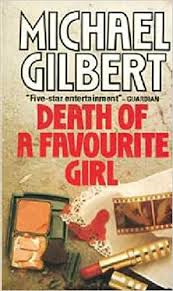 Death of a Favourite Girl (1980). Puzzle mystery. Also published as The Killing of Katie Steelstock. A fairly traditional puzzle mystery about the brutal killing of a young TV star who is visiting her home village. Part police procedural, part courtroom thriller, and with some very modern undercurrents that must have been quite risqué for 1980. With a surprising but exquisitely foreshadowed twist ending.
Death of a Favourite Girl (1980). Puzzle mystery. Also published as The Killing of Katie Steelstock. A fairly traditional puzzle mystery about the brutal killing of a young TV star who is visiting her home village. Part police procedural, part courtroom thriller, and with some very modern undercurrents that must have been quite risqué for 1980. With a surprising but exquisitely foreshadowed twist ending.
 The Doors Open (1949). Against great odds. Although this one has many of Gilbert’s recurring themes (part courtroom drama, part corporate thriller, part political thriller); essentially the story of an evil person who seeks a long, long revenge and is ultimately thwarted by a good man who wants to see justice done. A very satisfying ending.
The Doors Open (1949). Against great odds. Although this one has many of Gilbert’s recurring themes (part courtroom drama, part corporate thriller, part political thriller); essentially the story of an evil person who seeks a long, long revenge and is ultimately thwarted by a good man who wants to see justice done. A very satisfying ending.
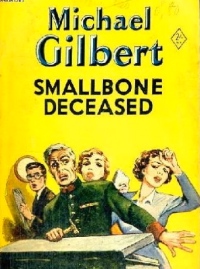 Smallbone Deceased (1950). Puzzle mystery. Often said to be Gilbert’s finest achievement; certainly it’s got everything you could want in a puzzle mystery. Inspector Hazelrigg investigates the case of a body found in a deed box in a staid and old-fashioned solicitor’s office. You understand the people, you are taught the routines of the daily grind of a solicitor’s office in a painless and intelligent way, and there’s a legal trick that you won’t see coming that underlies a major plot thread. I suspect the ending will surprise you very much; it’s logical but difficult to get to unaided.
Smallbone Deceased (1950). Puzzle mystery. Often said to be Gilbert’s finest achievement; certainly it’s got everything you could want in a puzzle mystery. Inspector Hazelrigg investigates the case of a body found in a deed box in a staid and old-fashioned solicitor’s office. You understand the people, you are taught the routines of the daily grind of a solicitor’s office in a painless and intelligent way, and there’s a legal trick that you won’t see coming that underlies a major plot thread. I suspect the ending will surprise you very much; it’s logical but difficult to get to unaided.
 They Never Looked Inside (1948). Also published as He Didn’t Mind Danger. Part detective story, part against great odds. Major McCann decides to help out Inspector Hazelrigg in the problem of ex-servicemen who are being recruited to commit crimes, and thereby runs up against a huge and vicious criminal organization.
They Never Looked Inside (1948). Also published as He Didn’t Mind Danger. Part detective story, part against great odds. Major McCann decides to help out Inspector Hazelrigg in the problem of ex-servicemen who are being recruited to commit crimes, and thereby runs up against a huge and vicious criminal organization.
 Death Has Deep Roots (1951). Puzzle mystery with a strong thread of courtroom drama. It’s the story of Victoria Lamartine, who was in France during WW2 and became pregnant; her handsome young Lieutenant Wells gets killed by the Germans. Vicky is also taken prisoner and her child disappears. She thinks the Lieutenant’s superior officer, Major Thoseby, might know what happened and spends years trying to find him after the war; she does, and he is murdered. The book details the courtroom process of her solicitors trying to defend her against that prosecution. I think this is an exceptional book and well worth your time if you like courtroom drama.
Death Has Deep Roots (1951). Puzzle mystery with a strong thread of courtroom drama. It’s the story of Victoria Lamartine, who was in France during WW2 and became pregnant; her handsome young Lieutenant Wells gets killed by the Germans. Vicky is also taken prisoner and her child disappears. She thinks the Lieutenant’s superior officer, Major Thoseby, might know what happened and spends years trying to find him after the war; she does, and he is murdered. The book details the courtroom process of her solicitors trying to defend her against that prosecution. I think this is an exceptional book and well worth your time if you like courtroom drama.
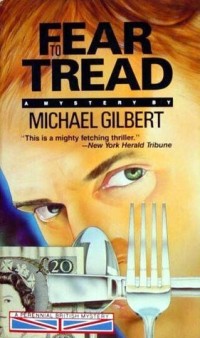 Fear To Tread (1953). Against great odds. This is the final Inspector Hazelrigg story but really it’s an “against great odds” story; Mr. Wetherall, headmaster of a boys’ secondary school, uncovers a large-scale black market operation and volunteers to assist the police in breaking it up. Mr. Wetherall is a delightful character and the twist in the ending is very satisfying.
Fear To Tread (1953). Against great odds. This is the final Inspector Hazelrigg story but really it’s an “against great odds” story; Mr. Wetherall, headmaster of a boys’ secondary school, uncovers a large-scale black market operation and volunteers to assist the police in breaking it up. Mr. Wetherall is a delightful character and the twist in the ending is very satisfying.
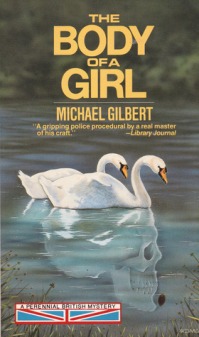 The Body of a Girl (1972). Puzzle mystery with overtones of the police procedural. Detective Chief Inspector Mercer is a hard man who comes to Stoneferry upon his promotion to DCI and leads the investigation of a corpse found in a well-known lovers’ lane. He also solves a couple of other crimes, some of which will surprise the reader. Mercer is a fascinating protagonist who has more to his character than is immediately obvious; a very satisfying ending.
The Body of a Girl (1972). Puzzle mystery with overtones of the police procedural. Detective Chief Inspector Mercer is a hard man who comes to Stoneferry upon his promotion to DCI and leads the investigation of a corpse found in a well-known lovers’ lane. He also solves a couple of other crimes, some of which will surprise the reader. Mercer is a fascinating protagonist who has more to his character than is immediately obvious; a very satisfying ending.
 Blood and Judgment (1959). Puzzle mystery. Inspector Petrella, in a full-length outing for once, investigates crimes for which one Boot Howton, a habitual criminal, is on trial. Petrella angers his superiors by coming up with an entirely unexpected line of inquiry into certain of the crimes and an entirely unsuspected criminal.
Blood and Judgment (1959). Puzzle mystery. Inspector Petrella, in a full-length outing for once, investigates crimes for which one Boot Howton, a habitual criminal, is on trial. Petrella angers his superiors by coming up with an entirely unexpected line of inquiry into certain of the crimes and an entirely unsuspected criminal.
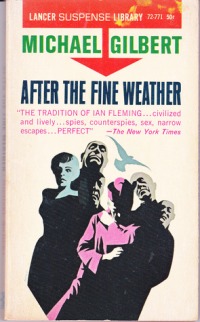 After the Fine Weather (1963). Political thriller. I’m not fond of this style of story and yet couldn’t stop reading this one; a young woman finds herself in danger because she is the only eyewitness to a secret about a political assassination in the Tyrol. Full of double and triple crosses and harsh political realities, a fast-moving story with plenty of excitement.
After the Fine Weather (1963). Political thriller. I’m not fond of this style of story and yet couldn’t stop reading this one; a young woman finds herself in danger because she is the only eyewitness to a secret about a political assassination in the Tyrol. Full of double and triple crosses and harsh political realities, a fast-moving story with plenty of excitement.
 Death in Captivity (1952). Also published as The Danger Within. Puzzle mystery. One of my favourite of all Gilbert’s novels, this is the story of a murder among Allied prisoners in an Italian prisoner-of-war camp in WW2. I don’t remember ever reading anything that seemed to be so accurate about the details of everyday life in a prison camp, while still providing fascinating material about who might kill a prisoner and why. My only quibble with this book is that the final sixth of the book has quite a different tone and approach than the rest of the book, and I found it somewhat jarring. The solution, though, is excellent. You’ll note from the Pan tie-in edition I’ve chosen to illustrate this that it was made into a film … which I haven’t yet found.
Death in Captivity (1952). Also published as The Danger Within. Puzzle mystery. One of my favourite of all Gilbert’s novels, this is the story of a murder among Allied prisoners in an Italian prisoner-of-war camp in WW2. I don’t remember ever reading anything that seemed to be so accurate about the details of everyday life in a prison camp, while still providing fascinating material about who might kill a prisoner and why. My only quibble with this book is that the final sixth of the book has quite a different tone and approach than the rest of the book, and I found it somewhat jarring. The solution, though, is excellent. You’ll note from the Pan tie-in edition I’ve chosen to illustrate this that it was made into a film … which I haven’t yet found.
 Paint, Gold & Blood (1989). Against great odds. I didn’t find the story of art smuggling all that fascinating, but there’s a wonderful process whereby two schoolboys get their revenge upon a cruel schoolmaster/churchman that is delightful, and there’s a business idea that’s probably worth doing to this day. The portrait of the brilliant young man who invents the idea is the centrepiece of the book; it’s a bit like Young Sherlock and Young Watson. There’s also a use of Samuel Pepys’ personal shorthand as a way of transmitting confidential information; many things to like about this book even if the art smuggling isn’t of much interest.
Paint, Gold & Blood (1989). Against great odds. I didn’t find the story of art smuggling all that fascinating, but there’s a wonderful process whereby two schoolboys get their revenge upon a cruel schoolmaster/churchman that is delightful, and there’s a business idea that’s probably worth doing to this day. The portrait of the brilliant young man who invents the idea is the centrepiece of the book; it’s a bit like Young Sherlock and Young Watson. There’s also a use of Samuel Pepys’ personal shorthand as a way of transmitting confidential information; many things to like about this book even if the art smuggling isn’t of much interest.
 Sky High (1955). Also published as The Country-House Burglar. Puzzle mystery. This is a story that John Rhode would have tackled but didn’t have the writing skill to bring to life; essentially a howdunit about a mysterious ex-Army type in a small village whose house explodes one summer night. It’s the characterization and dialogue that make this story the enjoyable book it is. I found the final chapter delightful; it ties off some loose ends in a very happy ending indeed.
Sky High (1955). Also published as The Country-House Burglar. Puzzle mystery. This is a story that John Rhode would have tackled but didn’t have the writing skill to bring to life; essentially a howdunit about a mysterious ex-Army type in a small village whose house explodes one summer night. It’s the characterization and dialogue that make this story the enjoyable book it is. I found the final chapter delightful; it ties off some loose ends in a very happy ending indeed.
 Stay of Execution and Other Stories of Legal Practice (1971). This is a set of short stories all of which are linked by the practice of law; some courtroom drama, some less than perfect lawyers, et cetera. Only a few of these are simple stories done to illustrate a point; more often than not they are complicated tales that lead you in one direction and then take you to a startling realization in a very satisfying way. Gilbert was, of course, a lawyer in active practice. Some of these stories will only really be satisfying to people who work in that profession, but they will be very satisfied indeed.
Stay of Execution and Other Stories of Legal Practice (1971). This is a set of short stories all of which are linked by the practice of law; some courtroom drama, some less than perfect lawyers, et cetera. Only a few of these are simple stories done to illustrate a point; more often than not they are complicated tales that lead you in one direction and then take you to a startling realization in a very satisfying way. Gilbert was, of course, a lawyer in active practice. Some of these stories will only really be satisfying to people who work in that profession, but they will be very satisfied indeed.
 The 92nd Tiger (1973). Political thriller. As I noted above, I’m an unlikely customer for this sort of novel but found it engaging and very readable. It’s the story of Hugo Greest, a TV actor who is the lead in a series about The Tiger, a karate-chopping womanizing spy. Just as his series comes to its end, Greest is offered a job by the leader of a small Persian Gulf country recently enriched by the discovery of a rare mineral; he is to equip and train a small army for the Ruler. Since he actually speaks Arabic this is not outrageously unreasonable. There’s a plot to supplant the Ruler and Greest, against great odds, stops the coup, rescues the Heir, and gets the girl. Not a shred of reality here, more like an extremely good-humoured James Bond novel or a very hard-hitting Dick Francis novel, but funny and gruesome by turns, and it held my attention.
The 92nd Tiger (1973). Political thriller. As I noted above, I’m an unlikely customer for this sort of novel but found it engaging and very readable. It’s the story of Hugo Greest, a TV actor who is the lead in a series about The Tiger, a karate-chopping womanizing spy. Just as his series comes to its end, Greest is offered a job by the leader of a small Persian Gulf country recently enriched by the discovery of a rare mineral; he is to equip and train a small army for the Ruler. Since he actually speaks Arabic this is not outrageously unreasonable. There’s a plot to supplant the Ruler and Greest, against great odds, stops the coup, rescues the Heir, and gets the girl. Not a shred of reality here, more like an extremely good-humoured James Bond novel or a very hard-hitting Dick Francis novel, but funny and gruesome by turns, and it held my attention.
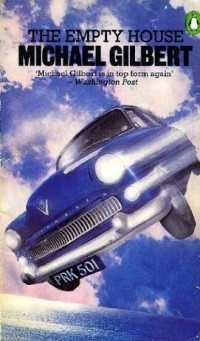 The Empty House (1979). Political thriller and against great odds. Young Peter Manciple is an inexperienced insurance adjuster assigned to investigate the death of a policy-holder whose car went over a cliff. This turns out to be merely the tip of the iceberg and lead to a plot involving international intrigue, romance, and biological warfare. It’s certainly an interesting story but I found the ending not quite up to Gilbert’s usual desire to leave the reader happy and satisfied; this is a little depressing and squalid.
The Empty House (1979). Political thriller and against great odds. Young Peter Manciple is an inexperienced insurance adjuster assigned to investigate the death of a policy-holder whose car went over a cliff. This turns out to be merely the tip of the iceberg and lead to a plot involving international intrigue, romance, and biological warfare. It’s certainly an interesting story but I found the ending not quite up to Gilbert’s usual desire to leave the reader happy and satisfied; this is a little depressing and squalid.
 The Final Throw (1982). Also published as End-Game. Against great odds. A young and rather dissolute Welshman goes undercover as a fairly incompetent tour guide around Europe in order to expose drug trafficking and organized crime. The stakes become very high when he must locate a down-and-out drug addicted vagrant who has some incriminating documents.
The Final Throw (1982). Also published as End-Game. Against great odds. A young and rather dissolute Welshman goes undercover as a fairly incompetent tour guide around Europe in order to expose drug trafficking and organized crime. The stakes become very high when he must locate a down-and-out drug addicted vagrant who has some incriminating documents.
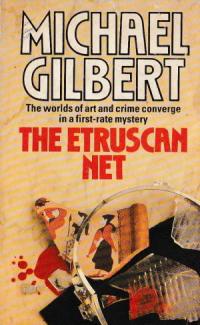 The Etruscan Net (1960). Puzzle mystery with a little bit of everything. Robert Broke is an Englishman in Florence running a small gallery. After touching on a potential case of forgery of Etruscan antiques, he finds himself up against the local Mafia and a ring of spies, and is soon on trial for manslaughter. A brilliant Italian defence lawyer solves the case and ties off all the loose ends. The Florentine background is interesting and it’s clear that Gilbert had some experience there.
The Etruscan Net (1960). Puzzle mystery with a little bit of everything. Robert Broke is an Englishman in Florence running a small gallery. After touching on a potential case of forgery of Etruscan antiques, he finds himself up against the local Mafia and a ring of spies, and is soon on trial for manslaughter. A brilliant Italian defence lawyer solves the case and ties off all the loose ends. The Florentine background is interesting and it’s clear that Gilbert had some experience there.
 The Night of the Twelfth (1976). Puzzle mystery and one of the most frightening books I’ve ever read — it’s about a serial killer who tortures, rapes, and murders young boys. The main part of the book takes place in the milieu of Trenchard House School, a boys’ school; a few senior boys and junior masters are the principal characters. Gilbert ably threads the difficulties of a very serious underlying plot and lifts the boys’ characters far, far above the Boys’ Own Paper level, helped by one who is the son of the Israeli ambassador and is accustomed to violence. A surprisingly intelligent book with a horrifying ending that had me on the edge of my chair.
The Night of the Twelfth (1976). Puzzle mystery and one of the most frightening books I’ve ever read — it’s about a serial killer who tortures, rapes, and murders young boys. The main part of the book takes place in the milieu of Trenchard House School, a boys’ school; a few senior boys and junior masters are the principal characters. Gilbert ably threads the difficulties of a very serious underlying plot and lifts the boys’ characters far, far above the Boys’ Own Paper level, helped by one who is the son of the Israeli ambassador and is accustomed to violence. A surprisingly intelligent book with a horrifying ending that had me on the edge of my chair.
 Ring of Terror (1995). Political thriller and much more. I wanted to end this on a high note; before this year I hadn’t read any of the three novels in a series about Luke Pagan and Joe Narrabone, and so I only obtained the first one, Ring of Terror. It’s my best discovery of any of this bunch, almost all of which I had read before — just a great novel. It’s a historical novel set in 1913 about young Luke Pagan whose knowledge of Russian makes him extremely valuable to the Metropolitan Police (and to the Home Secretary, one Winston Churchill). Pagan is set to investigate Russian immigrants; some anarchists, some merely criminals, and some entirely innocent — the stakes are very, very high and the story is exciting. I thought as I was midway through the book that this is the type of story that Gilbert was born to write. His command of the period is sufficient to convince me he’s done his research; we know the outlines of the politics involved but, like Churchill’s role, there will be much here that is new to the reader. Gilbert was not afraid to talk about the nasty, violent, and squalid as part of where he had to go with this book, and it’s a rather brutal reality for the protagonist, but it made for a fine and exciting story. Plot, characterization, and writing are all excellent. If I’d ever done a “Top 10 Michael Gilbert novels” list I would have had to revise it all downwards after finding this gem.
Ring of Terror (1995). Political thriller and much more. I wanted to end this on a high note; before this year I hadn’t read any of the three novels in a series about Luke Pagan and Joe Narrabone, and so I only obtained the first one, Ring of Terror. It’s my best discovery of any of this bunch, almost all of which I had read before — just a great novel. It’s a historical novel set in 1913 about young Luke Pagan whose knowledge of Russian makes him extremely valuable to the Metropolitan Police (and to the Home Secretary, one Winston Churchill). Pagan is set to investigate Russian immigrants; some anarchists, some merely criminals, and some entirely innocent — the stakes are very, very high and the story is exciting. I thought as I was midway through the book that this is the type of story that Gilbert was born to write. His command of the period is sufficient to convince me he’s done his research; we know the outlines of the politics involved but, like Churchill’s role, there will be much here that is new to the reader. Gilbert was not afraid to talk about the nasty, violent, and squalid as part of where he had to go with this book, and it’s a rather brutal reality for the protagonist, but it made for a fine and exciting story. Plot, characterization, and writing are all excellent. If I’d ever done a “Top 10 Michael Gilbert novels” list I would have had to revise it all downwards after finding this gem.

Michael Gilbert in later years
To my surprise there are still a bunch more, but I think I can mop up in a smaller post some time soon. I hope you try Ring of Terror on my recommendation, if you want the male version of Anne Perry with great writing skills, and if you like novels about a protagonist fighting against great odds, that’s Gilbert’s specialty and there are a bunch of titles here for you.
One final note: I wanted to mention that although it is my usual practice to show you the book from which I wrote the piece, that is not the case here. There are so many interesting editions of Michael Gilbert that I wanted to show you a few of the more interesting ones, but they are pictures I scavenged from the internet.
I have a few Gilbert books but know next to nothing about them. Thanks to your post I can put a face to a name. Looking forward to the second part.
There’s a few titles I haven’t tracked down yet — availability in Canada is sometimes worse than the rest of the world, although usually better. But there are a couple I have on hand but haven’t had a chance to go through yet also.
Thanks for yòur thoughts, including the strong recommendation of Ring of Terror, a book which I had not heard of before. You seem to like Michael Gilbert’s writings for the same reasons I do, so I very much look forward to your subsequent posts as well!
I only recently discovered Michael Gilberts books. I have The Crack in the Teacup and Long Journey Home. I find them more challenging to read the books of many GAD authors but agree that he writes beautifully. His word pictures are exquisite. I am glad to learn more about him and hope to discover more of his books over time. It’s a challenge as I live in Mexico where English language books can be very difficult to find.
I hope you’ll be able to find quite a few more of them inexpensively now that quite a few of his books have been published in e-editions.
Great stuff Noah – Michael Gilbert is always well worth celebrating 🙂
Thanks Noah, this is massively helpful. I come across Gilbert quite often in my second hand book trawls so will refer back to this post.
Blimey – I have been reading Gilbert for years, and know quite a lot about him, though have never tried to be completist about it. So I was sure I would be familiar with most of the books you would be mentioning, but that is far from the case. I have obviously let a lot of them slip to the edges.
I love Smallbone Deceased, and agree that Night of the Twelfth is a tour de force, astonishing.
And now will work on catching up with some of the others you mention.
Quite a few of his books, I think, are oriented towards male readers — at least they have covers and blurbs that play up the action and play down the intelligence, and the protagonists are always male. So I wouldn’t be surprised if your eye had skated right over those books in a bookstore. I was really excited to read the one about Luke Pagan just before WW1, though; it was exceptional and I think anyone will enjoy it.
[…] (Prompted by Noah Stewart’s post.) […]
An excellent piece about a first-rate writer.
[…] it’s a great pity that it did. So, I started looking at some older posts and found one on Michael Gilbert which sounded good. In looking up Michael Gilbert on Amazon, I realized I already had the first […]
[…] A brief look at Michael Gilbert […]
[…] A brief look at Michael Gilbert by the late Noah Stewart […]